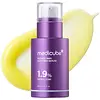What's inside
What's inside
 Key Ingredients
Key Ingredients

 Benefits
Benefits

 Concerns
Concerns

 Ingredients Side-by-side
Ingredients Side-by-side

Water
Skin ConditioningGlycereth-26
HumectantNiacinamide
SmoothingGlycerin
HumectantCaprylic/Capric Triglyceride
MaskingMacadamia Ternifolia Seed Oil
EmollientButylene Glycol
HumectantHydrogenated Lecithin
EmulsifyingRetinol
Skin ConditioningBrassica Campestris Sterols
Emollient1,2-Hexanediol
Skin ConditioningCholesterol
EmollientPolyglyceryl-10 Laurate
Skin ConditioningPhytosteryl/Behenyl/Octyldodecyl Lauroyl Glutamate
Skin ConditioningAluminum/Magnesium Hydroxide Stearate
Emulsion StabilisingPentaerythrityl Tetra-Di-T-Butyl Hydroxyhydrocinnamate
AntioxidantPotassium Cetyl Phosphate
EmulsifyingTris(Tetramethylhydroxypiperidinol)Citrate
StabilisingGlyceryl Citrate/Lactate/Linoleate/Oleate
EmulsifyingElaeis Guineensis Oil
EmollientCetyl Ethylhexanoate
EmollientHydroxyacetophenone
AntioxidantAmmonium Acryloyldimethyltaurate/Vp Copolymer
Polyacrylate Crosspolymer-6
Emulsion StabilisingAluminum Starch Octenylsuccinate
AbsorbentRetinal
Skin ConditioningSqualane
EmollientPolyquaternium-51
Skin ConditioningTocopherol
AntioxidantPanthenol
Skin ConditioningAllantoin
Skin ConditioningAdenosine
Skin ConditioningDisodium EDTA
Bifida Ferment Lysate
Skin ConditioningLactobacillus Ferment Lysate
Skin ConditioningLactococcus Ferment Lysate
Skin ConditioningDipropylene Glycol
HumectantCentella Asiatica Leaf Extract
Skin ConditioningAsiaticoside
AntioxidantAsiatic Acid
Skin ConditioningMadecassic Acid
Skin ConditioningBeta-Glucan
Skin ConditioningCeramide NP
Skin ConditioningPropanediol
SolventEriobotrya Japonica Leaf Extract
Skin ConditioningMentha Viridis Extract
MaskingSodium Hyaluronate Crosspolymer
HumectantPentylene Glycol
Skin ConditioningEthylhexylglycerin
Skin ConditioningNicotinamide Mononucleotide
AntioxidantAkebia Quinata Extract
Skin ConditioningCaprylyl/Capryl Glucoside
CleansingCamellia Japonica Flower Extract
EmollientPolyglyceryl-10 Oleate
Skin ConditioningAcetyl Hexapeptide-8
HumectantAcetyl Tetrapeptide-5
HumectantCarnosine
Skin ConditioningPalmitoyl Tetrapeptide-7
Skin ConditioningPalmitoyl Tripeptide-5
Skin ConditioningYeast Beta-Glucan
Skin ConditioningFerulic Acid
Antimicrobial3-O-Ethyl Ascorbic Acid
Skin ConditioningAscorbic Acid
AntioxidantWater, Glycereth-26, Niacinamide, Glycerin, Caprylic/Capric Triglyceride, Macadamia Ternifolia Seed Oil, Butylene Glycol, Hydrogenated Lecithin, Retinol, Brassica Campestris Sterols, 1,2-Hexanediol, Cholesterol, Polyglyceryl-10 Laurate, Phytosteryl/Behenyl/Octyldodecyl Lauroyl Glutamate, Aluminum/Magnesium Hydroxide Stearate, Pentaerythrityl Tetra-Di-T-Butyl Hydroxyhydrocinnamate, Potassium Cetyl Phosphate, Tris(Tetramethylhydroxypiperidinol)Citrate, Glyceryl Citrate/Lactate/Linoleate/Oleate, Elaeis Guineensis Oil, Cetyl Ethylhexanoate, Hydroxyacetophenone, Ammonium Acryloyldimethyltaurate/Vp Copolymer, Polyacrylate Crosspolymer-6, Aluminum Starch Octenylsuccinate, Retinal, Squalane, Polyquaternium-51, Tocopherol, Panthenol, Allantoin, Adenosine, Disodium EDTA, Bifida Ferment Lysate, Lactobacillus Ferment Lysate, Lactococcus Ferment Lysate, Dipropylene Glycol, Centella Asiatica Leaf Extract, Asiaticoside, Asiatic Acid, Madecassic Acid, Beta-Glucan, Ceramide NP, Propanediol, Eriobotrya Japonica Leaf Extract, Mentha Viridis Extract, Sodium Hyaluronate Crosspolymer, Pentylene Glycol, Ethylhexylglycerin, Nicotinamide Mononucleotide, Akebia Quinata Extract, Caprylyl/Capryl Glucoside, Camellia Japonica Flower Extract, Polyglyceryl-10 Oleate, Acetyl Hexapeptide-8, Acetyl Tetrapeptide-5, Carnosine, Palmitoyl Tetrapeptide-7, Palmitoyl Tripeptide-5, Yeast Beta-Glucan, Ferulic Acid, 3-O-Ethyl Ascorbic Acid, Ascorbic Acid
 Reviews
Reviews

Ingredients Explained
These ingredients are found in both products.
Ingredients higher up in an ingredient list are typically present in a larger amount.
This ingredient is an emollient, solvent, and texture enhancer. It is considered a skin-softener by helping the skin prevent moisture loss.
It helps thicken a product's formula and makes it easier to spread by dissolving clumping compounds.
Caprylic Triglyceride is made by combining glycerin with coconut oil, forming a clear liquid.
While there is an assumption Caprylic Triglyceride can clog pores due to it being derived from coconut oil, there is no research supporting this.
Learn more about Caprylic/Capric TriglycerideRetinol is a gold-standard ingredient for anti-aging. It is a form of Vitamin A and belongs to the class of retinoids that also includes tretinoin.
Why is retinol famous?
It has the most scientific studies backing up its skin benefits out of all the non-prescription ingredients.
Retinol is proven to:
This is why retinol is effective at removing wrinkles, fading dark spots, treating acne, and reducing the appearance of pores.
Studies show retinol is less effective when exposed to UV. Be sure to look for appropriate packaging to keep your retinol potent (similar to Vitamin C).
Using retinol or any retinoids will increase sun-sensitivity in the first few months. Though studies show retinoids increase your skin's natural SPF with continuous use, it is best to always wear sunscreen and sun-protection.
We recommend speaking with a medical professional about using this ingredient during pregnancy.
Retinol may cause irritation in some people, so be sure to patch test. Experts recommend 'ramping up' retinol use: start using this ingredient once a week and work up to using it daily.
Read about Tretinoin
Learn more about RetinolSqualane is an emollient that helps the skin hold onto moisture. It's an oily liquid that occurs naturally in certain types of fish and plant oils.
Because squalane boosts hydration in the skin, it also comes with plenty of benefits: it is an antioxidant and can help fight free radicals and skin damage. Squalane is also found to have a detoxifying effect when applied.
Squalane comes from squalene, which occurs naturally within the sebum of our skin. It is one of the oils our skin produces to keep itself hydrated. Squalane is the hydrogenated version of squalene and has a longer shelf life.
Research shows that squalane is non-irritating (even at 100% concentration).
In general, it's a fantastic ingredient. It does a great job at hydrating the skin, and it's suitable for those with sensitive skin.
The source of squalane may impact malassezia / fungal acne. This is because olive oil derived squalane can contain impurities such as fatty acids and plant waxes. Sugarcane derived squalane is recommended for anyone with malassezia concerns.
Is squalane vegan?
This depends on the source. Squalane can be derived from both plants and animals. Most squalane used in skincare comes from plants.
Please note: the source of squalane is only known if disclosed by the brand. We recommend reaching out to the brand if you have any questions about their squalane.
Read more about squalene with an "e".
Is squalane an oil?
Squalane is often called an oil, but it’s technically not; it’s a hydrocarbon, meaning it’s only made of carbon and hydrogen, unlike true oils which are triglycerides made of fatty acids and glycerol.
The term “oil-free” isn’t regulated, so companies can define it however they want. Some exclude all oils, while others just avoid mineral oil or comedogenic oils.
While some people avoid oils thinking they cause breakouts, the right kind of oil (or oil-like ingredient like squalane) can actually help balance and hydrate your skin. It’s worth testing out simple oils or squalane to see what works best for your skin.
Learn more about Squalane